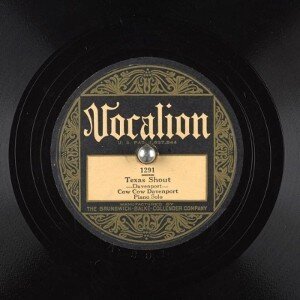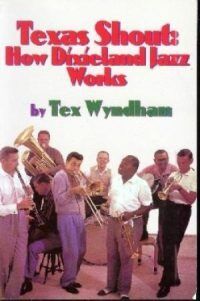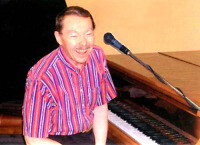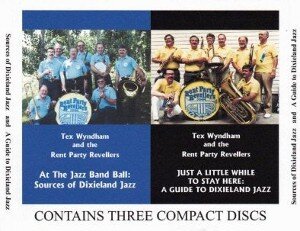 Set forth below is the ninth “Texas Shout” column. It first appeared in the August 1990 issue of The West Coast Rag, now known as The Syncopated Times.
Set forth below is the ninth “Texas Shout” column. It first appeared in the August 1990 issue of The West Coast Rag, now known as The Syncopated Times.
I have a Dixieland musician friend who, for purposes of today’s column, I’ll call “X”. (The name is actually Y, but I don’t like to get personal in print.) X is a talented and experienced player who takes a strongly purist, jazzman-as-artist, the-music-is-everything stance toward Dixieland.
Because I believe that nothing should ever dilute the integrity of the music being performed, X and I are on common ground most of the time. However, I am more of a ham at heart than X; that fact causes me, I think, to spend more time than X does in looking at Dixieland from the audience’s point of view.
X and I were working together on a gig not long ago. The leader on the gig likes to honor requests. As a result, we had just finished performing a tune that, it seems to me, gets requested every time this particular band plays. X and I were discussing whether the number in question had reached the status of being overplayed by the band.

During this discussion, I offered the view that the first and foremost thing a Dixieland band has to do, when it appears before paying customers, is entertain them. X’s face fell. X, like many other jazzmen, tends to equate the word “entertain” with being “commercial” — doing a whole lot of things on stage that you don’t much want to do, all of them at the expense of the quality of the music.
I don’t see it that way. To me, any band that doesn’t entertain its audience isn’t going to get much work. The trick is to find a way to be entertaining while still playing the way you want to play. Let’s acknowledge our common purpose of increasing the paying audience for Dixieland jazz. Let’s also recognize that, in order to do so, we are going to have to reach out beyond the tiny minority of persons who deeply understand and appreciate the music for itself alone. There aren’t enough of them, and never has been, to keep a Dixieland scene alive.
If we are going to extend our message beyond the already converted, we have to do something to make that message easily accessible to more people. If we want to attract non-jazz fans, to get them to dress up, give up whatever other activity they might have available that evening, come to our show and spend thirty dollars a couple or more on drinks and food, and return for more at our next gig, we must focus on making those folks glad they came. That is, they have to leave with the feeling that they’ve been well entertained.
Thus, if we don’t entertain them in the sense that I’ve described above, we aren’t doing our job. Does that mean we have to compromise on the quality of our music? I don’t think so at all. It does mean that we have to keep in mind that the average person does not instantly appreciate the merits of Dixieland jazz the first time he hears it, and that we have to package it in a way that guides him along the true path.
There are a zillion ways to package your musical product. None is more “right” than another, but they all require some effort and planning. If you want most people to go away feeling they got their money’s worth, you need to think about such matters and pick a method of presentation with which you feel most comfortable.
You might begin by asking yourself if you would go out once or twice a month and spend thirty dollars to see your own band perform. If not, why not? Given the other combos that are on the bill at the festival you’re playing, would you forsake the chance to see one that’s scheduled against you for the chance to see your own? Again, if not, why not?
To name one of the non-musical settings in which Dixieland is frequently found, lots of bandleaders use the space in between tunes to tell jokes. Indeed, I’ve seen at least one band that regularly involves several sidemen in elaborate comedy routines. We can all think of very popular groups on the circuit that obviously attract many fans who prefer to get their primary entertainment value from comedy and high spirits and only secondarily from the music.
Such an approach may offend purists, but I think it’s fine. Of the two bands I had in mind when I wrote the preceding paragraph, both – once the comedy is over – play good solid jazz that’s well worth hearing. Exposing the public to Dixieland of that quality is what we all should encourage, and if laughs help do so, I’m all for them.
Other bands package their Dixieland in a “personality” atmosphere, wherein the announcer establishes a special rapport with the audience on a personal level. This approach might be coupled with encouraging requests, or remembering the special favorite songs of certain fans.
Yet another common tack consists of supplying the audience with a little background, e.g., telling them who wrote the tune that’s coming up, who recorded it, or something historically interesting about it. Being a person who spends a lot of time thinking about how the music works and how it got that way, I find this an avenue that comes naturally to me, as anyone who’s ever seen one of my shows will tell you.
Dixielanders recognize that the principal audience for Dixieland today consists of older folks who go back to the swing years but not back to the twenties. Accordingly, some bands will include a few non-Dixieland tunes in their program — swing, ballroom dance, Latin, etc.
Who can deny that presenting a good-looking female vocalist will bring in some segments of the audience, or having a Red Hot Mama who flounces across the stage in a boa and sings naughty ditties? As long as you make sure she has musical talent, and the tunes she executes are worthy, so that you’re not watering down your jazz, we can all — Dixieland buffs and civilians alike — enjoy her time at the microphone.
If you have no vocalist, do any of your sidemen have singing talent? If so, including a fair number of vocals in each set gives the neophytes in the audience something to which they can relate, a way of distinguishing one tune from the other. Besides, many of these old pops have great lyrics that will enhance your overall performance if properly utilized.
The point here is that, if you expect people to take the time and trouble, and pay the money, to attend your programs, you should, whether you like it or not, pay attention to all aspects of your programs, the musical and non-musical ones, and to the way they fit together. Your show is going to have some kind of presentation, and you can either do something to control and improve that presentation or not. If you don’t, I’ll bet that your show won’t be as entertaining as the show of someone who does, even if both shows are indistinguishable musically.
You’re probably thinking that what I’ve outlined sounds like extra work for you to do. Well, it is. But much of it involves activities that will get done by default if you don’t grab the ball.
For example, how about the tune list? All of us have been bored to death at one time or another by bands that get on stage without any idea of what they’re going to play, and then stand around trying to decide. You’re going to pick the tunes sometime, so why not in advance?

Clothing? You’re going to wear something on stage, so you might as well give some advance thought to wearing apparel that will enhance your show in the eyes of the audience you’re trying to reach. Many bands use distinctive uniforms in order to look neat and well-organized. Conversely, lots of “British trad”-style jazzmen, possibly in an attempt to focus attention on the music itself or maybe as a subtle way of reminding the audience of the folk origins of the uptown New Orleans Dixieland from which British trad derives, deliberately appear in casual clothes.
Timing? If you’re playing a non-festival gig, you’ll probably need to take some breaks. Do you have a clear idea of how long your sets and intermissions will last? Or is yours one of those bands that ends a set, gets involved in discussions with the customers and returns to the bandstand about ten minutes after half the audience has checked their watches for the third time?
Along the same lines, does your show start when it’s supposed to? We’ve all been annoyed by situations where we’ve rushed to get to a tavern early to get a good seat, and then the band members drift in five minutes before the gun and yak away among themselves for twenty minutes or so before playing a note.
For the benefit of any Dixieland combos out there that are just getting off the ground, I’ll use the balance of this column to share with you some of the principles I follow with the band I’ve led in Wilmington, Delaware for over a quarter-century, The Red Lion Jazz Band. They’ll provide a preliminary checklist of things you might want to think about. Though I find them useful, I hold no special brief for them. Keep in mind that there are lots of other ways to operate, and all of them can be successful ones.

The Red Lions appear in coordinated uniforms whenever we play. If we’re appearing before a general audience, I think it helps get them in a mood to enjoy the music if we wear what they expect us to, which is colorful vests and string ties. For jazz clubs and festivals, our Red Lion polo shirts, or white shirts and ties, take over.
On typical-length four-hour gigs, we play five sets of thirty-five minutes each (the first one runs forty minutes), with four fifteen-minute breaks. Personally, I think the standard twenty-minute break is just a little long for the audience, and by structuring the gig this way, we try to keep it moving while taking about the same amount of total break time as other bands.
Our sets on such gigs run six numbers each, usually half vocals and half instrumentals. Tune lists are made up well in advance, with copies available to the sidemen (so the rhythm section can turn to the next tune in our chord books without delay while I’m making the announcement). I like to start a set with a fast tune (to get everyone’s attention) and end the same way (to leave them on a high), but in between we play dance-tempo tunes at slow and medium tempos. If we’re doing any special feature numbers, I keep them spaced through the evening.
In fact, I think some tunes work better early in a show and some later. I try to build the flow of excitement so that it peaks at the end of the fourth set, with the fifth (often a late set with only die-hards left at the tables) being a relaxed collection of danceable vintage pops.
I try to schedule at least two or three “familiar” tunes in each set, i.e., ones that most people with a working knowledge of Dixieland or older popular music will recognize and treat as old friends. I personally enjoy playing standards anyway, but beyond that, I think doing so helps keep the crowd listening through the several total obscurities we’ll do that night. If we’re playing a jazz club or festival, where the audience is more sophisticated jazz-wise and is often anxious to hear new material, I’ll reduce the percentage of standards, but never take it down to zero.
I think that a show should be as unpredictable as possible. My view is that, once the audience thinks it knows what’s going to happen next, its attention is likely to start wandering. If you keep things changing on stage, they’re less likely to look away, fearing they’ll miss something.
For that reason, I never program two consecutive songs in the same tempo or same key. Not only does this policy maintain variety, but it also helps challenge the part-time musicians who staff most Dixieland bands and who need every push they can get to avoid chord-running and over-reliance on favorite licks. Also, I think even a listener with a tin ear will eventually develop a sense of deja vu if you play too many tunes in the same key without a break. (I carry this fetish to what is probably a fanatical extreme by trying to avoid scheduling a tune that will begin with the same chord with which the prior song ended, or by avoiding two straight numbers that use either opening vamps or twelve-bar blues patterns.)
The Red Lions start and stop on time, and take our breaks on time, even if a sideman is late, or if there’s practically no one in the room. That’s what we’re being hired to do, and if there’s only one customer on hand, he’s paid his money and he’s entitled to the show he came to see. Personally, I have no patience with leaders who say “Let’s not start until the room fills up a little more”; besides, who wants to walk in and sit down in a nearly-empty room in which nothing is happening?
If you’ve hired the Red Lions to play your private party, we’ll play whatever tunes you want us to. However, during the years when we were playing Wilmington restaurants, I wouldn’t take requests on our recurring monthly gig. We had too many regular fans who each had a special favorite tune, and we’d have played about half our program from their list every time. I felt that such repetition would not get the rest of the audience coming regularly, so I made sure that the tunes we played at our recurring gig didn’t come up too often.
Those principles worked for us through eighteen virtually-uninterrupted years of first-Friday performances at four local watering holes — until downtown Wilmington at night went the ghost-town route of most older cities its size and the hotels where we played remodeled their dining rooms so that they no longer had space for a Dixieland band and a dance floor. Following these practices, we found out something else, too — if the non-musical part of a show is crisp and tight, if the band looks and acts like it knows what it’s doing, an audience is much more likely to forgive (or not even notice) some of those musical on-stage glitches that happen occasionally to all Dixieland bands.
To sum up, if I’m going to rent a movie, read a book, attend a concert, or spend money on any leisure-time activity, I expect to be “entertained” by it in the sense that I want to come away from it thinking I got value for my investment. Dixieland bands are no exception to this rule. If we play well, we can expect to sell our recordings to Dixieland buffs. If those buffs don’t get something extra, something entertaining beyond our music, when they come to see us live, we can expect that they will decide next time to stay home and listen to those records.
At the risk of beating this point to death, let me reemphasize that, to be entertaining, you don’t have to tie a confederate flag on the end of your clarinet, or march around the room, or work the trombone slide with your foot (but if you really like to do those things, that’s O.K. too). You can and should always play the tunes you prefer, as well as you’re able. But if you want most of us to share your enjoyment in doing so, you really ought to use your presentation to give us some help in that direction.
You’ll be pleasantly surprised at how quickly and eagerly we respond to such consideration. After all, we came to see you to have a good time, didn’t we? We’ve arrived at your gig already disposed to enjoy ourselves. Meet us halfway; you’ll find more of us returning next time.
Back to the Texas Shout Index.

The full run of “Texas Shout” has been collected into a lavishly illustrated trade paperback entitled Texas Shout: How Dixieland Jazz Works. This book is available @ $20.00 plus $2.95 shipping from Tex Wyndham, On request, Tex will autograph the book and add a personalized note (be sure to tell him to whom the note should be addressed).
Tex Wyndham’s 3 CD Guide to Dixieland with music and commentary is available for $20 plus $2.95 shipping. The separate CD, A History of Ragtime: Tex Wyndham Live At Santa Rosa, is available for $13.00 plus $2.00 shipping. On request, Tex will autograph the inner sleeve and add a personalized note (be sure to tell him to whom the note should be addressed).
Send payment to Tex Wyndham, P.O. Box 831, Mendenhall, PA 19357, Phone (610) 388-6330.
Note: All links, pictures, videos or graphics accompanying the Shouts were added at the discretion of the Syncopated Times editorial staff. They did not accompany the original columns and do not necessarily reflect the opinion of Tex Wyndham.
From roughly 1970-2010, Tex Wyndham was: (1) one of the best-known revivalist Dixieland jazz musicians in the US, as cornetist, pianist and bandleader, (2) one of the best-known ragtime pianists in the US, and (3) one of the most respected critics in the US of Dixieland jazz, ragtime, and related music. He is the only person about whom all three of those statements can be made.




